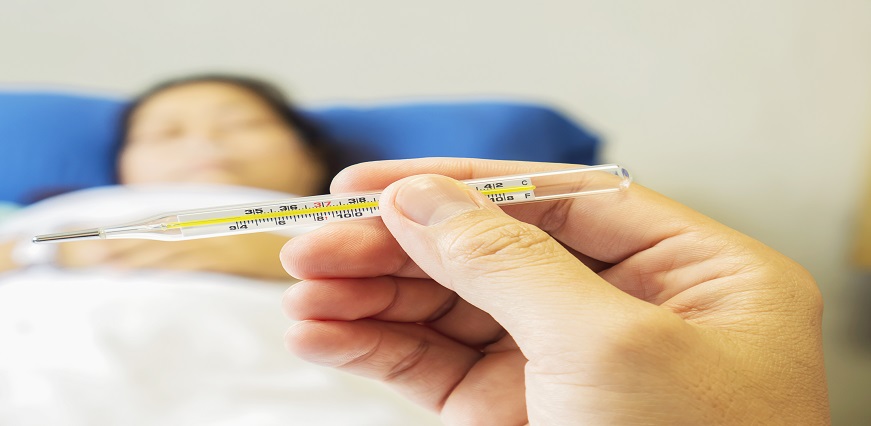A bacterial infection called typhoid can spread throughout the body and harm several organs. It is used by a bacterium called Salmonella typhi, present in animal and human intestines, that is passed via faeces and urine. Early signs and symptoms of typhoid fever usually include body weakness, high fever, diarrhoea or constipation, weight loss, red spots, and abdominal pain. If the condition is not treated on time, it can lead to life-threatening complications. The majority of infection cases spread through an infected person keeping unhygienic habits. The two main ways typhoid fever spreads are through contact with an infected person and by consuming polluted water. Samples of blood, poop, or urine can be analysed to make a precise diagnosis. Several tests can be used to detect typhoid infection in the body, like a bone marrow test and stool culture test, which involves collecting faecal matter to determine the presence of bacteria. Another effective method is to detect antibodies against Salmonella typhi bacteria using the Widal test.
What is Widal Test?
A Widal test is a quick and simple blood test that confirms or rules out enteric fever, also known as typhoid fever, even when the symptoms are mild. Usually, it takes anywhere between 6 to 30 days for the initial symptoms of fever to appear after being exposed to an infection. There are multiple reasons doctors prescribe a Widal test.
In biological terms, a Widal test is used for detecting antibodies against flagellar (H) and somatic (O) antigens that cause infection and typhoid fever. On infection, these antigens stimulate the body to produce specific antibodies. The Widal test analyses the interaction between these antigens and antibodies found in the blood samples of the patients.
Who Should Get Tested for Widal Test?
If a person is showing symptoms of typhoid fever, the doctor may want to look into his/her Widal test reports for a better diagnosis. These symptoms include:
- High fever with head and body aches
- Abdominal pain, constipation, and possibly diarrhoea.
- Red Spots on the body
- Weakness and a loss of appetite
- Agitation, confusion, and, in the worst-case, hallucinations.
How is Widal Test Performed?
There is no need for special preparation, and no fasting is required. The blood sample is carefully taken by inserting a thin needle into the vein in your arm. The sample is then sent to a laboratory for diagnosis.
It is accomplished through the use of slide agglutination and tube agglutination tests. Agglutination, also known as blood grouping, is a process that occurs when an antigen interacts with the corresponding antibody, causing bacteria or red blood cells to clump in the presence of the antibody. These compact clump structures then form a large complex-like shape that keeps any foreign matter out.
Methods of Widal Testing:
-
Qualitative Method
One drop of undiluted blood serum is placed on the slides, followed by one drop of O, H, AH and BH antigen. After mixing the contents with a separate applicator stick, the slide is gently rocked for a minute. If no agglutination is observed the test is considered negative.
- Quantitative Method
Followed after a positive qualitative test, it is a semi-procedural Widal tube test that includes testing the positive antigens with the blood sample to confirm the slide agglutination.
Because the slide Widal test has higher sensitivity but lower specificity, it should be used for screening, but positive slide test results should be confirmed by the tube Widal test.
Maxlab offers an exhaustive list of tests for a comprehensive diagnosis of your health. Take a look at Widal test for detecting antibodies against flagellar (H) and somatic (O) antigens that cause infection and typhoid fever.
Price of Widal Test
Widal tests are rapid, low-cost diagnostics that are typically performed in impoverished nations where typhoid disease is common. The cost of the Widal test may vary depending on factors like location and lab centre. The widal test with Max Labs only costs Rs 280.
Understanding Widal Test Results and Ranges
A Widal test needs thorough and precise interpretation and can be analysed by understanding the titre value. For a proper diagnosis, titres ranging from 1:20, 1:40, 1:60, 1:80, 1:160, and 1:200 need to be included in the diagnosis to obtain the typhoid test report.
- Negative Result - A negative, commonly considered a normal range for a Widal test result is when the value of O and H antigens are less than 1:160.
- Positive Result - A titre of O and H antigens greater than 1:60 to 1:320 is considered positive. A positive Widal test result means there is a presence of salmonella typhi in the blood.
The Widal test is a simple and inexpensive way to test for a typhoid infection, even in places where medical reaches are scarce.
Typhoid is not a thing of the past. Due to inadequate sanitation and a lack of clean drinking water, this disease is on the rise in urban and rural regions of most developing countries. But if timely evaluated, and the typhoid patient is properly cared for through a specific diet and regular medication, the disease can be handled easily.













 7982100200
7982100200
























 To reach our help desk call 9213188888
To reach our help desk call 9213188888.png)
Comments